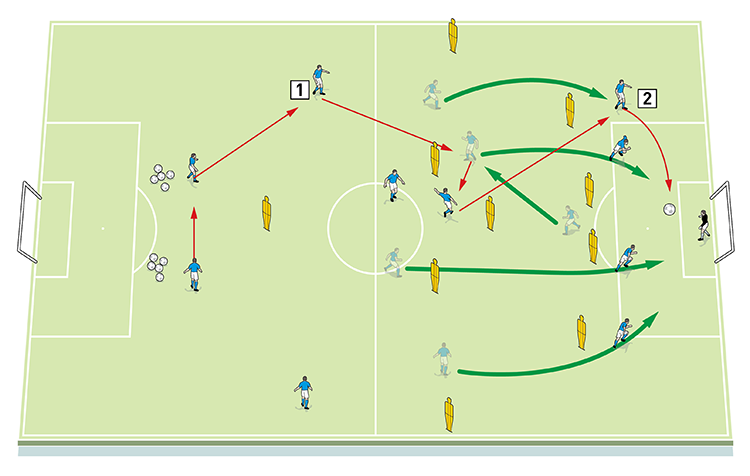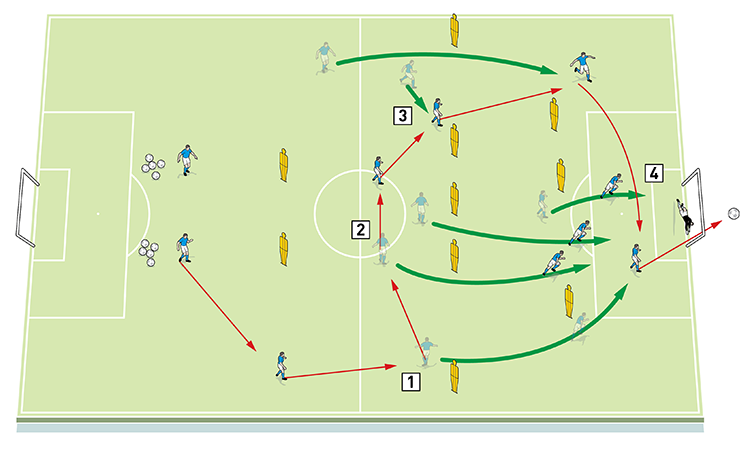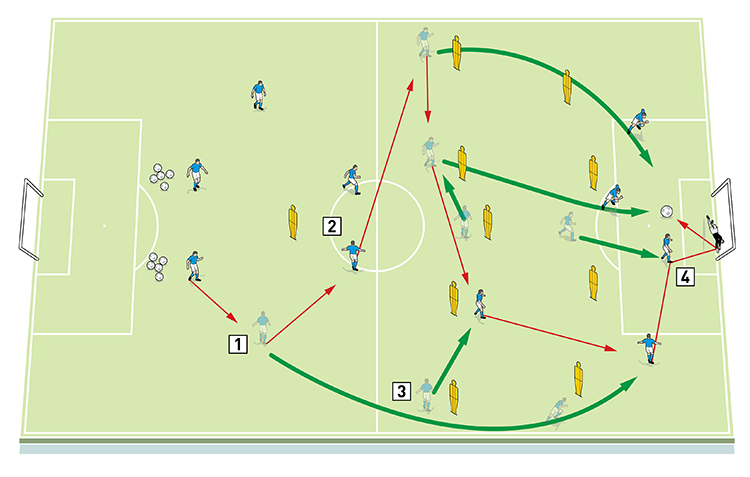




OUR BEST EVER OFFER - SAVE £100/$100
JOIN THE WORLD'S LEADING PROFESSIONAL DEVELOPMENT PROGRAMME
- 12 months membership of Elite Soccer
- Print copy of Elite Player & Coach Development
- Print copy of The Training Ground
You are viewing 1 of your 1 free articles
Attacking patterns
I often use this type of practice to work on our team shape and attacking patterns in preparation for matches. The patterns and movements we rehearse will vary greatly, depending on the system we intend to use for the game and the system we expect our opponents to use.
| Area | Full pitch |
| Equipment | Balls, bibs, cones, mannequins, 1 full size goal |
| No. of Players | Initially 10 players + 1 goalkeeper. But up to 20 players + 2 goalkeepers for the game |
| Session Time | Attacking patterns: 20min |
I often use this type of practice to work on our team shape and attacking patterns in preparation for matches. The patterns and movements we rehearse will vary greatly, depending on the system we intend to use for the game and the system we expect our opponents to use.
People accept that in professional football, teams must be organised defensively when they do not have possession. When the ball is in certain areas of the pitch, players need to understand how and where to position themselves in relation to the ball, the opposition, the goal and their team mates.
It is equally important for players to understand their positioning and movement when we have possession. As a coach, you can use this session to prepare players to play against specific opposition tactics. The players can be coached on how to exploit weaknesses we have identified in the opposition’s expected shape and system.
What do I get the players to do?
After a warm-up with the fitness coaches and a passing drill based on the type of work we intend to do [not shown], we set up for the main session on a full size pitch with a goal and a goalkeeper at one end. The diagrams show 10 outfield players, set up in a 4-2-3-1/4-4-1-1 shape, but to ensure that the full squad understand what we are working on, we often double players up in most positions. For each session we will set up 10 mannequins in the expected shape of the forthcoming opponents.
Pattern 1
Play starts with a pass from the centre back to the right back, who combines with the midfielder to pass back to the starting player. When the starting player receives the ball back from the midfielder, the left winger moves infield to receive and pass in to the striker. Whilst the move is developing, the left back overlaps to receive a pass from the striker and crosses into the penalty area, where his team mates have made runs to meet the ball, as shown [1].
1

2. The left winger moves infield to receive and pass in to the striker
3. The overlapping left back receives from the striker and crosses into the penalty area, where his team mates have made runs to meet the ball
Pattern 2
Play starts with a pass between the centre backs and then to the right back, who passes to the number 10 who then passes to the supporting midfield player. The midfield player then passes into the path of the right winger, who crosses, as shown [2].
2

2. The midfield player passes into the path of the right winger, who crosses
3. The striker holds his run until the pass is on its way to the right winger and tries to meet the cross
Pattern 3
Play starts with a pass between the centre backs and then the ball is passed to the left back. The left back receives and passes to the number 10 who passes to the supporting midfield player who passes to the right winger, who has moved inside. The right winger turns and plays into the path of the overlapping right back who crosses, as shown [3].
3

2. The left back plays the ball into midfield and the number 10 drops deep to receive. At the same time, the left winger and one of the central midfielders make forward runs
3. The striker holds his run until the overlapping right back approaches the penalty area
4. When the right back receives a pass from the right winger who has come inside, he crosses into the area
Pattern 4
Play starts with a pass between the two centre backs and then the ball is played to the left back, who passes directly to the striker. The striker lays the ball off to the number 10, who plays the ball into the path of the running left winger to make a cross in the box, as shown [4].
4

2. The striker drops deep and receives from the left back. He lays the ball off to the number 10, who plays the ball into the path of the left winger to cross
Pattern 5
Play starts with a pass from the centre back to the right back, who plays the ball to the right winger. The right winger passes inside to the first central midfielder who passes to the second central midfielder, who passes to the left winger who has moved inside. The left winger passes to the overlapping full back who crosses, as shown [5].
5

2. The first central midfielder lays the ball off to the second central midfielder and makes a forward run into the penalty area
3. The left winger moves inside to receive from the second central midfielder and passes to the overlapping left back
4. The striker holds his run to arrive late in the box and the attackers try to meet the cross from the overlapping left back
Pattern 6
The right back receives and plays into midfield, as shown [6]. The midfield player switches play to the left winger who has stayed wide. The left winger passes to the number 10 who turns and passes to the right winger who has moved inside. The right winger turns and passes into the path of the overlapping right back who crosses.
6

2. The midfield player switches play to the left winger who has stayed wide. The winger then passes to the number 10 and makes a back post run
3. The right winger cuts inside to receive the ball from the number 10 and passes to the overlapping right back
4. The striker holds his run until he sees the overlapping right back approaching the penalty area to receive and cross
What are the key things to look out for?
We want to see a good quality of passing, crossing and finishing. Players should make well-timed runs and should demonstrate an understanding of their own movement in relation to the movement of their team mates.
What are the typical mistakes players might make and how do I avoid them?
Things that can let down the successful execution of an attacking pattern are poor technique, poor timing and poor understanding.
How would I put this into a game situation?
After we have practised the attacking patterns that I want to work on, we may go into an 11v11 game [not shown] with one team arranged in our formation and the other in the expected shape of our opponents. When we progress into the 11v11 game, the players should show that they recognise the patterns from the practices we have just done.
Related Files
Editor's Picks
Attacking transitions
Deep runs in the final third
Using the goalkeeper in build-up play
Intensive boxes drill with goals
Penetrating the final third
Creating and finishing
My philosophy
Pressing initiation
Compact team movement
Coaches' Testimonials

Alan Pardew

Arsène Wenger

Brendan Rodgers

Carlos Carvalhal

José Mourinho

Jürgen Klopp

Pep Guardiola

Roy Hodgson

Sir Alex Ferguson

Steven Gerrard
Coaches' Testimonials

Gerald Kearney, Downtown Las Vegas Soccer Club

Paul Butler, Florida, USA

Rick Shields, Springboro, USA

Tony Green, Pierrefonds Titans, Quebec, Canada
Join the world's leading coaches and managers and discover for yourself one of the best kept secrets in coaching. No other training tool on the planet is written or read by the calibre of names you’ll find in Elite Soccer.
In a recent survey 92% of subscribers said Elite Soccer makes them more confident, 89% said it makes them a more effective coach and 91% said it makes them more inspired.
Get Monthly Inspiration
All the latest techniques and approaches
Since 2010 Elite Soccer has given subscribers exclusive insight into the training ground practices of the world’s best coaches. Published in partnership with the League Managers Association we have unparalleled access to the leading lights in the English leagues, as well as a host of international managers.
Elite Soccer exclusively features sessions written by the coaches themselves. There are no observed sessions and no sessions “in the style of”, just first-hand advice delivered direct to you from the coach.








